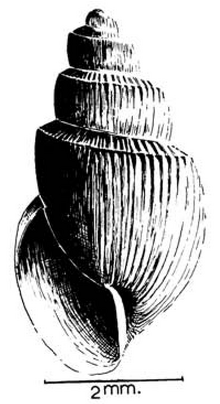

Sculpture is a feature of many of the shells of mollusks. It is three-dimensional ornamentation on the outer surface of the shell, as distinct from either the basic shape of the shell itself or the pattern of colouration, if any. Sculpture is a feature found in the shells of gastropods, bivalves, and scaphopods. The word "sculpture" is also applied to surface features of the aptychus of ammonites, and to the outer surface of some calcareous opercula of marine gastropods such as some species in the family Trochidae.[1]
Sculpture can be concave or convex, incised into the surface or raised from it. Sometimes the sculpture has microscopic detailing. The term "sculpture" refers only to the calcareous outer layer of shell, and does not include the proteinaceous periostracum, which is in some cases textured even when the underlying shell surface is smooth.
In many taxa, there is no sculpture on the shell surface at all, apart from the presence of fine growth lines. The sculpture has a protective function because it increases the diameter of the shell, distributing mechanical stress (such as the force of a predator's jaws) across a larger surface area.[2]
- ^ Ward, Peter (1981). "Shell Sculpture as a Defensive Adaptation in Ammonoids". Paleobiology. 7 (1). Cambridge University Press: 96–100. Bibcode:1981Pbio....7...96W. doi:10.1017/S009483730000381X. JSTOR 2400643. Retrieved 21 November 2020.
- ^ Palmer, A. Richard (June 1979). "Fish Predation and the Evolution of Gastropod Shell Sculpture: Experimental and Geographic Evidence". Evolution. 33 (2). Society for the Study of Evolution: 697–713. doi:10.2307/2407792. JSTOR 2407792. Retrieved 21 November 2020.